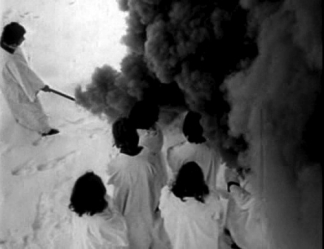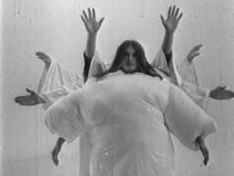Indeed, the sequencing of the strange activities depicted in the film might even be seen as an oblique and poetic version of the collective’s larger history. The first half of the film takes place in a bare interior curiously reminiscent of a white cube gallery space. In it, men and women, both clothed and naked, strain against the walls of a tiny, confined room and then jump in an open space through a penlike structure they have built. This is followed by scenes of ebullient play, some of it highly suggestive of an orgy between young people covered only in soap foam. There is even a moment of scandalous homoeroticism when two men kiss briefly as they eat the same pasta noodle. These scenes also abound in images of animals—such as geese, sheep, and mice—who inhabit the same space as the humans, matching the color of their white, gender-neutral robes. Finally, in several scenes, both humans and animals interact with powdery, liquid, or malleable substances (such as flour, milk, and boiled pasta) whose amorphousness allows for their easy manipulation. Though direct references are hard to establish, much of this imagery evokes OHO’s aesthetics at the moment when the group was at its biggest and first achieved wide visibility around 1968–69. In those years, OHO members both staged urban happenings and, influenced by Italian arte povera, presented exhibitions that contained arrangements of raw, unshaped materials (such as hay, bricks, tar, and soap bubbles) put on display in gallery space, with live rabbits being let loose in at least one such installation.
The second half of White People takes place in nature, as if to reflect the fact that starting in 1969, the broader movement turned into a smaller artist group which often ventured into rural areas to stage works that would subsequently be shown through photographs or film documentation, the latter frequently made by Naško Križnar. In the film, the robed white people perform cryptic, ritualistic actions together first on a shore and then in an open snowy field (the same field in the town of Kranj, where Križnar and his friends first started making films, including 19th Nervous Breakdown). The camera also captures the preoccupation in OHO’s later work with elemental forces of nature such as water and fire.
The color white in the film seems to represent purity, innocence, the erasure of old preconceptions, and a sense of openness to new possibilities and ways of seeing the world. The reasons for such optimism on the part of the artists were short-lived in late 1960s Yugoslavia. Yet the film is a testament to the hope that its creators had for a world where sexual liberation and a heightened awareness of one’s environment would lead to greater harmony on every level, from the communal to the cosmic. In finding visual form for their hopes, OHO members were expressing the same sentiment that the Serbian film director Dušan Makavejev articulated regarding his 1965 film Man Is Not a Bird, writing, “The film expressed my beliefs [that] the only acceptable socialism would be one with human faces and bodies."[4]
Makavejev’s remark highlights the significance of White People’s opening credits, which list not actors but “bodies,” drawing attention to the film’s celebration of corporeal sensuality and OHO’s rethinking of personal identity in embodied terms. The bodies’ craving for contact in the film also becomes a metaphor for OHO’s utopian vision of physically and spiritually attuned collaborative living and art-making that the four-person group of Marko Pogačnik, Milenko Matanović, Andraž Šalamun, and David Nez tried to achieve before disbanding in 1971. The power of the communal ideal reflected in White People persisted, however. In 1971, Marko Pogačnik founded a commune in the village of Šempas called the Šempas Family, and two other OHO members—Milenko Matanović and David Nez—spent time in the 1970s at the Findhorn commune in Scotland. All of them, as well as Naško Križnar, identify the burst of collective creativity they experienced as part of OHO to have been a formative experience at a time, when, as Milenko Matanović puts it, “I felt that to succeed by the prevailing standards would force me to fail as a human being.”
— Ksenya Gurshtein
With thanks to Naško Križnar, Gordana Nikolić, Museum of Contemporary Art Vojvodina, and Aleksandar Erdeljanović and the staff of the Yugoslav Cinematheque (Jugoslovenska Kinoteka), Belgrade, for their assistance with research and help in making a screening of this film possible in Washington.


